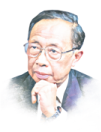Fifth Industrial Revolution will be more people-centered with focus on value-added

The world is now approaching the Fifth Industrial Revolution, during which the focus will shift back to humanity and promote the integration of Homo sapiens, artificial intelligence and the environment to bring about an energy revolution, said a world-renowned engineering expert.
Chan Ching Chuen, an academician at the Chinese Academy of Engineering, said at the latest Vision China event on Thursday that the key challenges for the energy revolution involve three factors-sustainability, affordability and reliability-and the possible solution is through low carbon, intelligent, electrification and hydrogen-driven modalities.
"The Fourth Industrial Revolution is (characterized) by AI. Of course, AI makes big contributions. However, we have discovered that only AI is not enough (to meet the challenges of the energy revolution)," Chan said, adding that, "Now the energy network is becoming (more) complex, and the solution is to integrate AI with humans and with the environment."
Along with the Fifth Industrial Revolution, the European Union has proposed Industry 5.0, which complements the existing Industry 4.0 paradigm by highlighting research and innovation as drivers for a transition to a sustainable, human-centric and resilient European industrial infrastructure.
The Japanese government has also attached greater importance to humanity and proposed Society 5.0-a society where various societal needs are finely differentiated and met by providing the necessary products and services in the required amounts.
In fact, Chan is now working on the integration of four networks (energy, information, transportation and humanity) and four flows (energy, information, material and value)-an original theory that will help the nation gain more economic and environment benefits and lead the pack in the latest industrial revolution as well as promote the energy revolution.
In his opinion, energy networks, information networks and transportation networks are the three pillars of the economic foundation, while the humanity network is an important part of the superstructure. And through the integration of the four networks and four flows, the proactive initiative of humanity can be combined with the energy revolution, information revolution and transportation (mobility) revolution.
Based on the integration of the four networks and four flows theory, Chan and industry experts from Huawei Technologies, State Power Investment Corp, the China Institute of Communications and the Chinese Society for Electrical Engineering jointly compiled and issued a white paper in December.
Through establishing a new production relationship formed by the human-machine-physical system, huge productivity from big data of the Fourth Industrial Revolution can be further explored, which is growing exponentially upon the sum of the total productivity of the previous three industrial revolutions, said the white paper.
Chan highlighted the four networks and four flows integration combines the energy tech and information tech through a smart energy operating system already developed, with energy tech combined with cloud tech, edge computation, artificial intelligence and big data tech to achieve value-added results, which will drive energy transition from the fourth toward the Fifth Industrial Revolution.
He explained that the four flows integration principle will help tackle and overcome four big conflicts-the conflict between fossil energy and renewable energy, centralized energy and distributed energy, primary energy and secondary energy as well as between electrical power and chemical energy.
"Through the theory of 4N4F, we can have an intelligent energy system that can convert waste into useful (forms), and at the same time promote carbon utilization through the energy internet coupling the energy flow and material flow and achieve a carbon neutral, smart energy ecosystem," Chan added. "By using the integrations of four networks and four flows, we can promote the energy sector from the Fourth Industrial Revolution to the Fifth Industrial Revolution."
Embracing the upcoming Fifth Industrial Revolution, Chan said his new theory will help further reduce energy intensity, increase material value and promote carbon neutrality.
"The nature of the four networks and four flows (theory) is a human oriented Renaissance. (The integration of four networks) and four flows is the key to meet challenges of energy evolution from the fourth industrial revolutions towards the fifth industrial revolution. And the energy revolution needs to be built upon the integration of human, AI and environment."






















